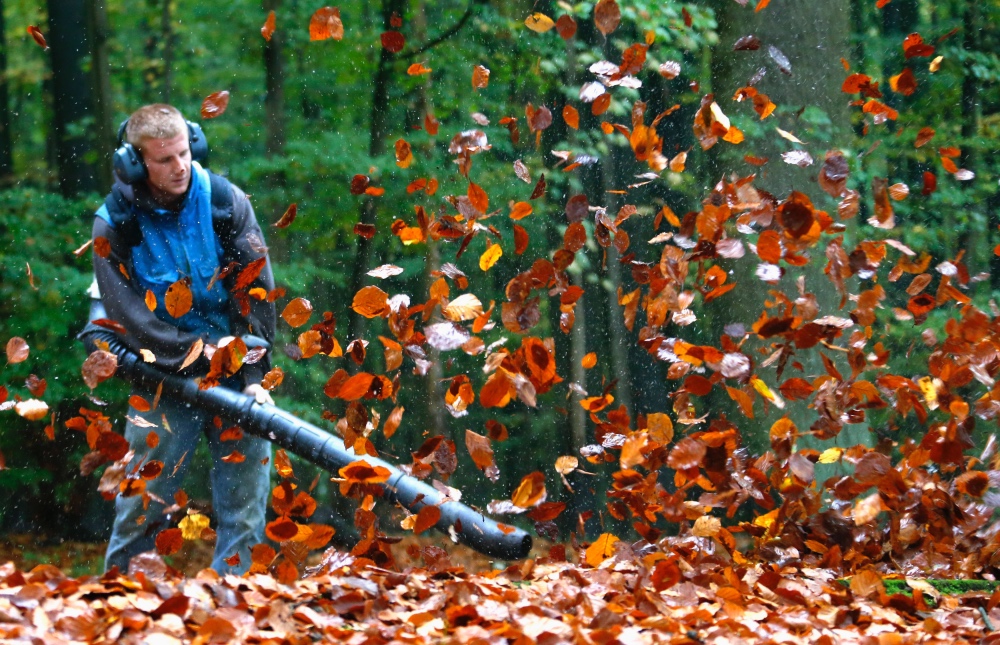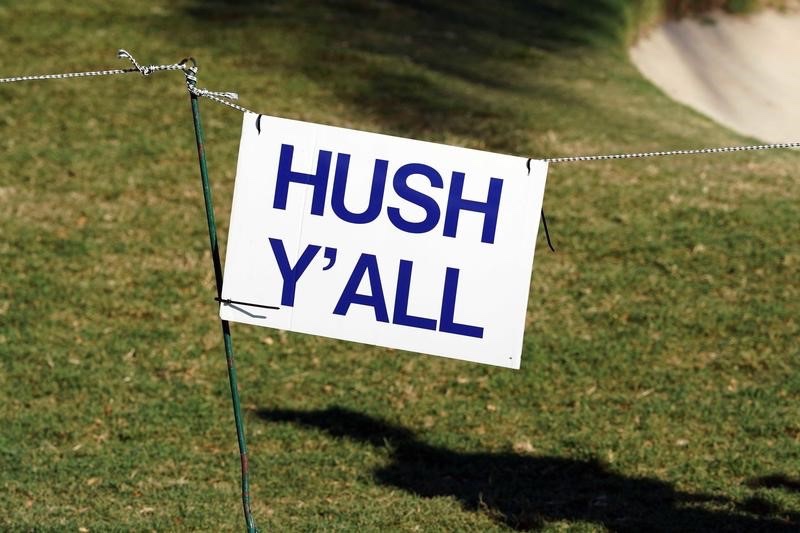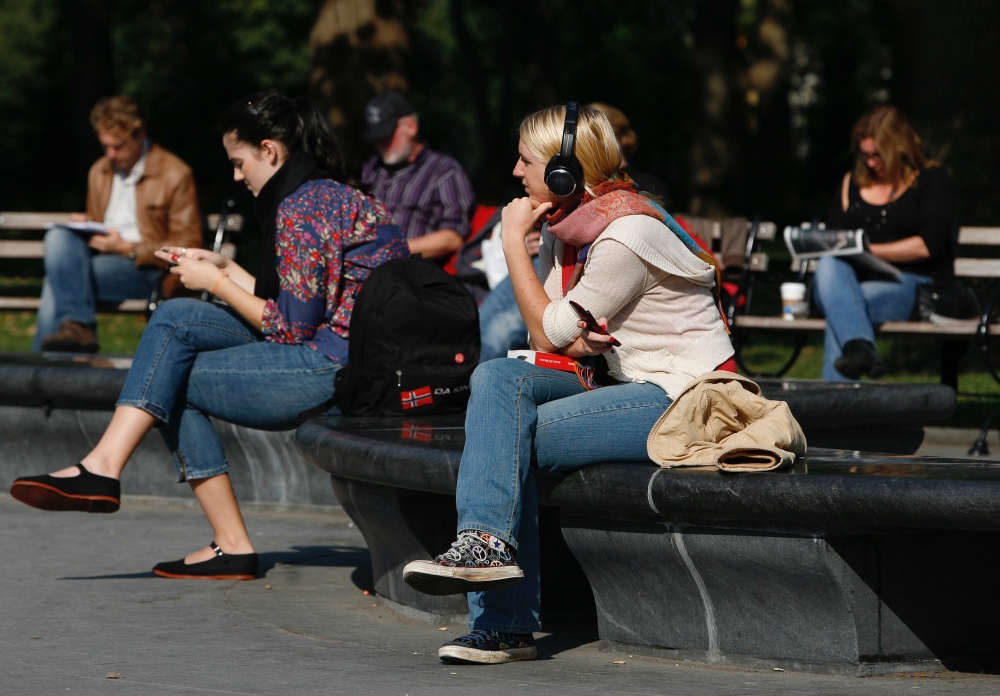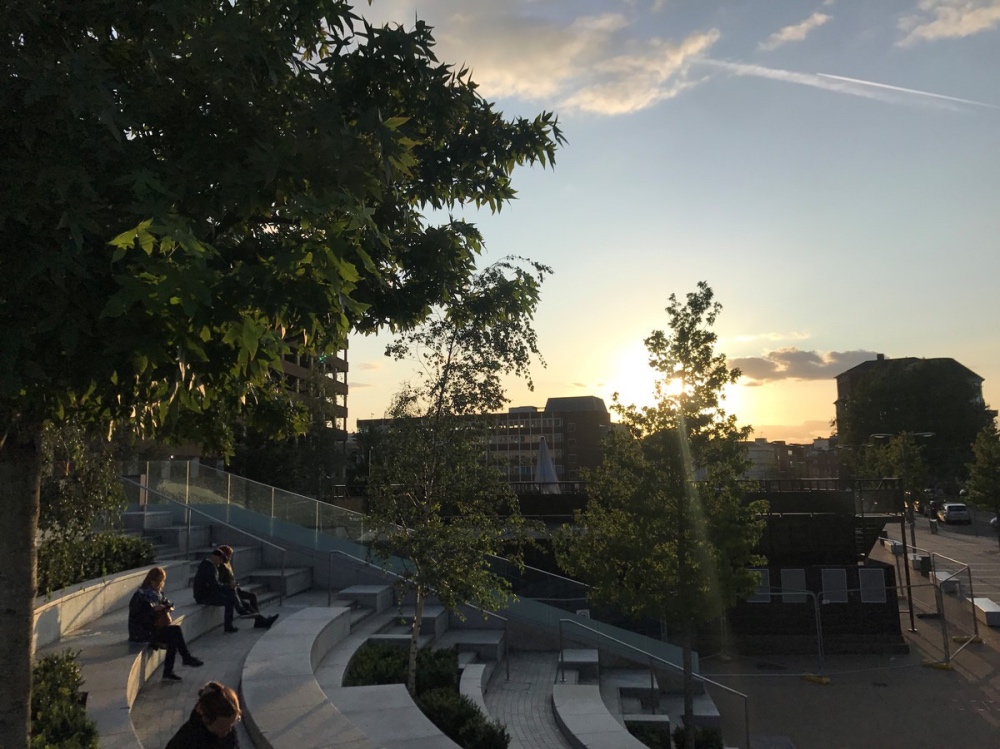
CAREY L BIRON and ADELA SULIMAN, of Thomson Reuters Foundation, report on growing demands for quiet in cities acorss the world…
Washington DC, US/London, UK
Thomson Reuters Foundation
Music teacher and composer Haskell Small remembers when the noise became too much for him.
“I couldn’t find a place to get some fresh air without noise,” he said of the day a half-decade ago.

A gardener cleans a park with a leaf blower during an autumn in Tervuren, near Brussels., on 30th October, 2012. More than 100 US jurisdictions have banned certain types of blowers in favour of quieter battery-operated machines. PICTURE: Reuters/Francois Lenoir
Small, 71, who works out of his Washington home, said the focus of his ire was a specific piece of lawn equipment: the gas-powered leaf blower.
“I accept that living in a city will have more noise, but this particular type of noise is piercing and very loud – aaargh!” he yelled at the Thomson Reuters Foundation.
“I accept that living in a city will have more noise, but this particular type of noise is piercing and very loud – aaargh!”
– Haskell Small, a music teacher, composer and Washington, DC, resident.
Many in his neighbourhood felt the same way, so they organised and, last December, convinced the city to join more than 100 other US jurisdictions in banning the blowers in favour of quieter battery-operated machines.
Washington’s action against auditory assault is just one example of a growing trend of cities around the world purposefully trying to slow and quiet urban life, with an eye on improving health and wellbeing.
Efforts to slow the pace of city life range from the literal – with many cities pushing for lower speed limits on their roads – to the imaginative, such as looking for ways to promote mindfulness.
Many of them include a recognition of the rising importance of public spaces that are geared more toward quiet and contemplation than efficiency and technology.
Noise, for example, is the “new secondhand smoke”, according to the Quiet Coalition, a Massachusetts-based non-profit.
“We’re in a noisier and noisier world,” said the group’s executive director, Jamie L Banks. Finding ways to change that is “urgent”, he said.
The World Health Organization has said the health risks of living in noisy cities can include hearing loss, cardiovascular disease and sleep disorders.
Europe has been particularly proactive on the issue, adopting a directive in 2002 that aims to reduce environmental noise pollution. It warns European Union members that prolonged exposure could lead to “harmful effects” on health.
But in the United States, there has been no federal regulation on noise since the late 1970s. That has left local jurisdictions such as Washington to act in response to growing public demand for quiet.

A sign on the 16th hole for fans to be quiet during the first round of the Sony Open in Hawaii golf tournament at Waialae Country Club in January. PICTURE: Brian Spurlock-USA TODAY Sports
The idea of cities trying to lower the volume and slow down is not new.
This year, a global network of more than 260 cities will celebrate 20 years of stepping on the brakes.
The Cittaslow – or Slow City – network began in Italy in 1999 and takes its inspiration from the Slow Food movement. It grades its members according to factors such as sustainable infrastructure, promotion of local economies and fairness.
“The effect is positive connection, because we put people in contact with each other,” said secretary general Pier Giorgio Oliveti of the network that spans 30 countries so far.
Cittaslow’s approach could be “a vaccine” for the ills of modernity, he said.
“Our residents have begun to recognise the meaning of a slower but still good life.”
– Maciej Sitarek, mayor of Lidzbark in Poland
For instance, since its entry into the slow-city network in 2015, Lidzbark in Poland has redeveloped its riverfront, introduced free electric public transport, and built new bike lanes and a public square, according to its mayor Maciej Sitarek.
“Our residents have begun to recognise the meaning of a slower but still good life,” he said by email.
One of the network’s larger members is Jeonju, a South Korean city of about 650,000 people that sits on the Jeonjucheon River.
Part of the Cittaslow network since 2016 – though one historic village in its boundaries joined in 2010 – Jeonju’s leaders have sought to slow the city while maintaining its identity.
They run monthly car-free zones, hope to plant 10 million trees by 2026 and are “transforming a straight eight-lane road into a curvy four-lane road” with a slower speed limit, Mayor Seung-su Kim said in an email interview.
“We are going through a phase to become a better city in the future,” he added.
However, the Jeonju projects have seen some pushback, Kim acknowledged, with a share of residents complaining that the lower speed limits make driving more complicated, while others say trying to maintain old traditions could hamper development.

People sit in Washington Square Park at New York University in New York, on 21st October, 2009. PICTURE: Reuters/Shannon Stapleton
Some international experts also have expressed concern that many of the feel-good interventions integral to the slow cities movement mainly are available only in wealthier communities or to people living in small towns.
Other pushback has come from industries rejecting greater regulation.
That is a key reason the US Government has essentially halted federal efforts to foster quiet across the country, said Arline Bronzaft, professor emerita at the City University of New York and a leading expert on noise reduction.
And not everyone considers quiet their priority.
In one community near Houston, Texas, residents in June voted down a measure to limit landscaping noise, with some worried the law would push up service prices and make it harder for landscapers to make a living.
“Efficiency is always linked with speed, which doesn’t need to be the case. Slow and smart are not opposites – they can work very well together.”
– Lakshmi Rajendran, a researcher who looks at future cities at Anglia Ruskin University in Cambridge
For Lakshmi Rajendran, a researcher who looks at future cities at Anglia Ruskin University in Cambridge, a warning bell went off last year when the British government created a ministerial position to counteract loneliness.
A subsequent public campaign found that almost half of British adults report their busy lives stop them from connecting with others.
“Efficiency is always linked with speed, which doesn’t need to be the case,” Rajendran said. “Slow and smart are not opposites – they can work very well together.”
Rajendran and her colleagues are now looking at ways to slow down the busy city centres of both Cambridge and Istanbul, by drawing attention to their historical heritage.
Rajendran said the idea is to explore how architecture, culture, and a sense of community identity can provide unique, “localised” experiences.
For instance, the project might use art projections or augmented reality in public spaces to connect citizens to the past and make them “pause a bit and contemplate”, she said.
“As everyone becomes glued to their mobiles and online communities, physical contact is being lost,” Rajendran said. “Slowness could help bring that back.”

The sun sets in the southern English town of Reading as users of a mobile phone app map quiet spaces in the city – shown on 5th September. PICTURE: Thomson Reuters Foundation/Adela Suliman
In the English town of Reading, a group of residents recently used apps and online communities to find silence together, huddling around their phones in parks, graveyards and bookstores.
The local walking group, led by sound artist Richard Bentley, was part of a global citizen-led initiative in September to map out quiet public places.
“Quiet spaces allow you to change gear,” Bentley told the Thomson Reuters Foundation in a hushed tone.
“[They] really help us get a distance from our day-to-day lives and being caught up in the various demands on our time and attention.”
Free public sound walks take place regularly in cities from Berlin to Chicago and many of the walkers use the Hush City phone app, which allows them to record audio, take photographs and rate quiet spots for others to seek out.
With the United Nations estimating that more than two-thirds of humanity will live in urban areas by 2050, Bentley expects noise from things such as traffic, construction and mobile phones will only increase – which could lead to peace and quiet becoming a commodified luxury.
“Historically, noise has had to be endured by those on lower incomes and [of] lower status,” he said. “Those with generally more means can move away.”
Which is why Bentley and others spend their spare time finding and logging free-to-access pockets of peace in their cities, as though they were endangered species.
“It’s incredibly important to keep these quiet spaces, and to be aware of their possible disappearance,” he said.





